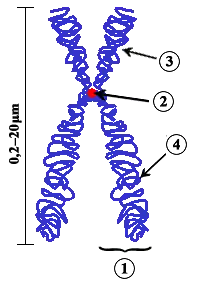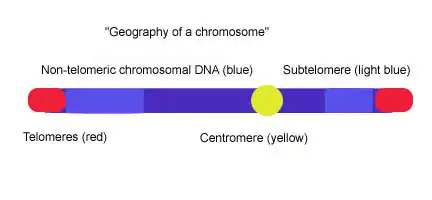Chromosome regions
Several chromosome regions have been defined by convenience in order to talk about gene loci. Most important is the distinction between chromosome region p and chromosome region q. These are virtual regions that exist in all chromosomes.

During cell division, the molecules that compose chromosomes (DNA and proteins) suffer a condensation process (called the chromatin condensation) that forms a compact and small complex called a chromatid. The complexes containing the duplicated DNA molecules, the sister chromatids,[1] are attached to each other by the centromere(where the Kinetochore assembles). The centromere divides each chromosome into two regions: the smaller one, which is the p region, and the bigger one, the q region. The sister chromatids will be distributed to each daughter cell at the end of the cell division.
The p region is represented in the shorter arm of the chromosome (p is for petit, French for small) while the q region is in the larger arm (chosen as next letter in alphabet after p).[2]
At either end of a chromosome is a telomere, a cap of DNA that protects the rest of the chromosome from damage. The areas of the p and q regions close to the telomeres are the subtelomeres, or subtelomeric regions. The areas closer to the centromere are the pericentronomic regions. Finally, the interstitial regions are the parts of the p and q regions that are close to neither the centromere nor the telomeres, but are roughly in the middle of p or q.

References
- "National Human Genome Research Institute (NHGRI) - Centromere". National Human Genome Research Institute (NHGRI). Retrieved 2018-11-19.
- "Short arm of a chromosome". MedicineNet. Retrieved 2016-04-10.